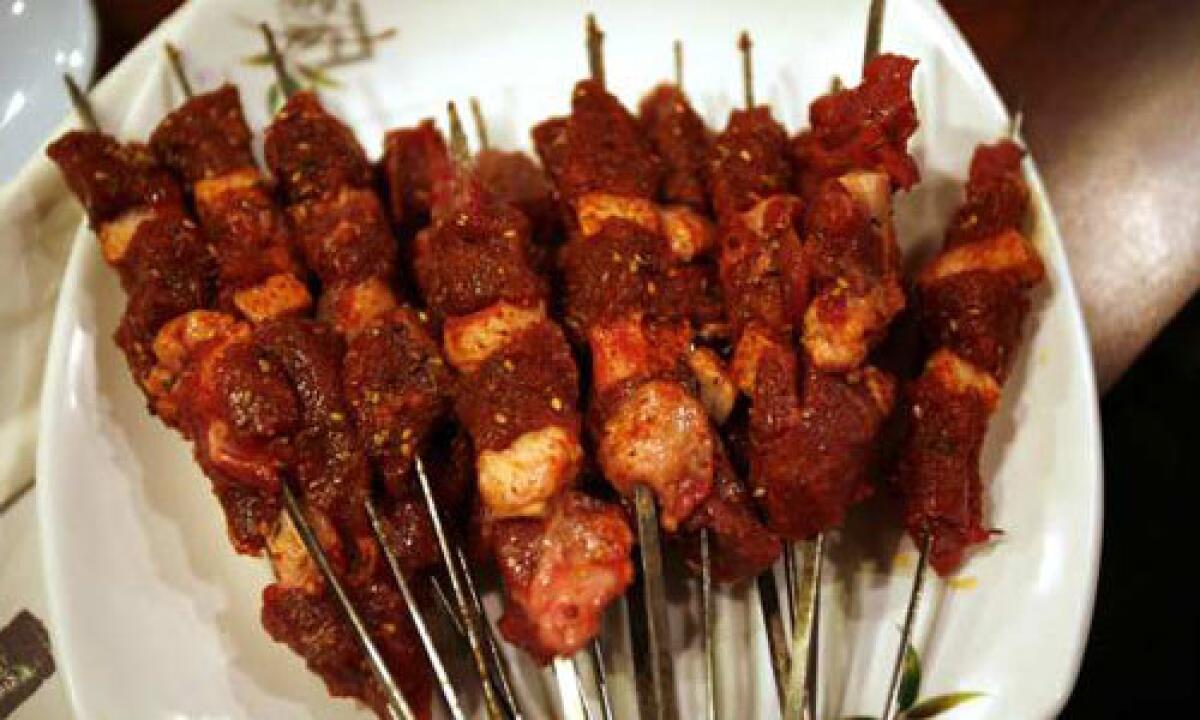Restaurant review: Feng Mao in Koreatown

- Share via
Tiny flecks of fire jump from Feng Mao’s tabletop grills. They’re unpredictable at first, but as the embers slowly brighten to white-hot, the flames calm down. Once the entire dining room gets cooking, the Koreatown restaurant fills with a familiar scent: a meaty smoke that works its way into the very fibers of your clothes.
But Feng Mao isn’t a typical Korean restaurant. In fact, it’s merely a hyphenated one, a months-old Korean-Chinese restaurant that’s adapting its recipes to an eight-table space on Olympic Boulevard.
Feng Mao’s crossover cuisine isn’t without explanation. Owner Jin Chun-Hua and her husband hail from China’s Jilin province, a northeastern state that borders North Korea. Within Jilin is the Yanbian Korean Autonomous Prefecture, a section of the province with a Korean community that once accounted for nearly two-thirds of the prefecture’s population. That you can hear Mandarin and Korean spoken at Feng Mao makes perfect sense. That Jin and her husband chose to camp their Korean-Chinese cooking in Koreatown is even more fitting.
Yang rou chuan, carefully spiced mutton skewers served in orders of 10, is the restaurant’s headliner. The Beijing-style skewers are ordered at what seems like every table in the place, where neighborhood regulars there for their usual fix mix with newcomers eating on Jin’s advice. The mutton -- lean cubes rubbed with a complex spice blend that contains mainly cumin, sesame and chile powder -- even receives a prominent spot on the restaurant’s sign.
Two-tier grilling
Besides the meat’s quality, what separates Feng Mao’s yang rou chuan is the restaurant’s addition of the grill-it-yourself element of Korean barbecue. It takes a skewer or two to master the technique -- charring the mutton on the grill’s lower rack before moving the meat to a second, slower tier -- but the staff is there to help if necessary, palming a half-dozen skewers at once while flipping and rearranging them with the kind of speedy skill seen only among the most sure-handed street vendors.
The mutton cooks quickly, grilling over such a high heat that the meat all but dissolves on the tongue. Give the mutton an extra dip in an accompanying bowl of that cumin-driven spice mix -- a powder that coats the meat like crushed clay -- and it becomes increasingly addictive. There’s banchan (boiled peanuts, kimchi and the like) to accompany the skewers, but the meat is best with a sip of Hite or Tsingtao beer.
Feng Mao offers more than just mutton. Chicken, squab and quail are all on the menu, as are assorted cuts of pork and beef. Most non-mutton skewers are available a la carte, which is good for offal eaters eyeing kidney, heart, liver and even bull penis skewers, the last of which arrives as tough, tiny slices that are best left to Feng Mao’s most curious customers.
There’s also a table-side basket filled with garlic and shallots should you want to cook up a few cloves with your meal.
Although the grill is the primary focus at Feng Mao, it isn’t the only option -- the kitchen also prepares a number of worthwhile entrees. There’s a stir-fry of shredded pork with cilantro and chiles and some spicy mapo tofu, a chile-shocked mix of tofu and minced meat.
There are also plenty of vegetables, including quick-cooked eggplant and bean sprouts and a cool cucumber salad.
Definining terms
Because the trilingual menu is written in Chinese, Korean and English, its sparse descriptions are sometimes lost in translation. What the menu calls Chinese sausage, for example, is actually a platter of soondae, the black-as-coal Korean blood sausage.
Similarly, onmyeon is described only as “warm noodle soup.” But onmyeon, the steaming cousin of Korea’s classic cold buckwheat noodle dish naengmyeon, is underserved by that explanation. Feng Mao’s onmyeon is actually far more interesting: a huge bowl of noodles steeped in a red pepper broth that has the same bold bite as an Italian arrabiata sauce.
Even with two full pages of entrees, Feng Mao’s skewers still dominate.
Although some tables might tune in to the restaurant’s flat-screen TV while their gizzards and chicken wings cook, most won’t be able to tear themselves from the sizzling spectacle.
More to Read
Sign up for The Wild
We’ll help you find the best places to hike, bike and run, as well as the perfect silent spots for meditation and yoga.
You may occasionally receive promotional content from the Los Angeles Times.










